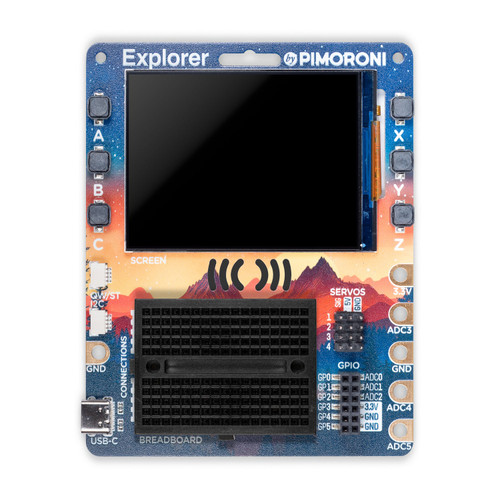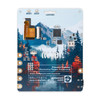

PIM720 - An electronic adventure playground for physical computing, built around the RP2350 chip. Includes a 2.8" LCD screen, a speaker, a mini breadboard, and much more!
This Explorer lets you play with circuits, build science experiments and prototype tiny robots and inventions. We've incorporated tinkering essentials like:
- a convenient mini breadboard for wiring up components
- servo headers
- analog inputs
- a built in speaker for making beeps and boops
- plenty of general purpose inputs/outputs
- connectors for attaching crocodile leads
- Qw/ST connectors for attaching I2C breakouts
Next to all that lot, there's a vibrant 320 x 240 pixel IPS LCD screen surrounded by six chunky tactile buttons so you can easily monitor and control what your project is doing. It's all mounted on a nice, sturdy baseboard that's printed with a fancy full colour silkscreen. We've also included some little legs, so you can have it propped up at an angle as well as lying flat, and there's a battery connector on the back so you can keep things portable.
You can buy a Pico Explorer board on its own or as part of a Starter Kit, which also contains a whole bunch of fun components to start tinkering with.
Features
- Powered by RP2350B (Dual Arm Cortex M33 running at up to 150MHz with 520KB of SRAM)
- 16MB of QSPI flash supporting XiP
- 2.8” IPS LCD screen (320 x 240 pixels)
- Driver IC: ST7789V
- Luminance: 250 cd/m2
- Active area: 43.2 x 57.5mm
- USB-C connector for programming and power
- Mini breadboard
- Piezo speaker
- 6x user-controllable switches
- Reset and boot buttons
- 6x crocodile clip terminals
- 4x 3-pin servo outputs
- 6x GPIO and 4x ADC easy access headers, plus 3.3V power and grounds
- 2x Qw/ST (Qwiic/STEMMA QT) connector
- 2-pin JST-PH connector for adding a battery
- Lanyard slot!
- Includes 2x desktop stand feet
- Fully-assembled (no soldering required)
- Programmable with C/C++ or MicroPython
- Dimensions: approx 107mm x 85mm x 16mm (H x W x D, assembled)
Connecting Breakouts
If your breakout has a Qw/ST connector on board, you can plug it straight in with a JST-SH to JST-SH cable, or you can easily connect any of our I2C breakouts with a JST-SH to JST-SH cable coupled with a Qw/ST to Breakout Garden adaptor.
About RP2350
The RP2350 chip is the Double Quarter Pounder & Fries to the RP2040's Double Cheeseburger and can have one or more RISC-V burgers instead of either of the M33 ARMs, to stretch the metaphor.
In addition to the modern M33 ARM cores, there are sides of: more PIO capability, a variety of low power states for sipping electrons, a whole security system and some sprinklings of specialist digital video circuits to offload DVI/HDMI output.
You can expect a tasty boost in performance - our "real world" MicroPython tests are running up to 2x faster compared to RP2040, and floating point number crunching in C/C++ is up to 20x faster. The extra on-chip RAM will make a big difference when performing memory intensive operations (such as working with higher resolution displays) and even more can be added thanks to external PSRAM support.
RP2350 comes in two flavours - A (standard) and B (all the pins). The B chip has a stonking 48 usable GPIO pins, including 8 ADCs and 24 PWMs, and features on some of our new products.



